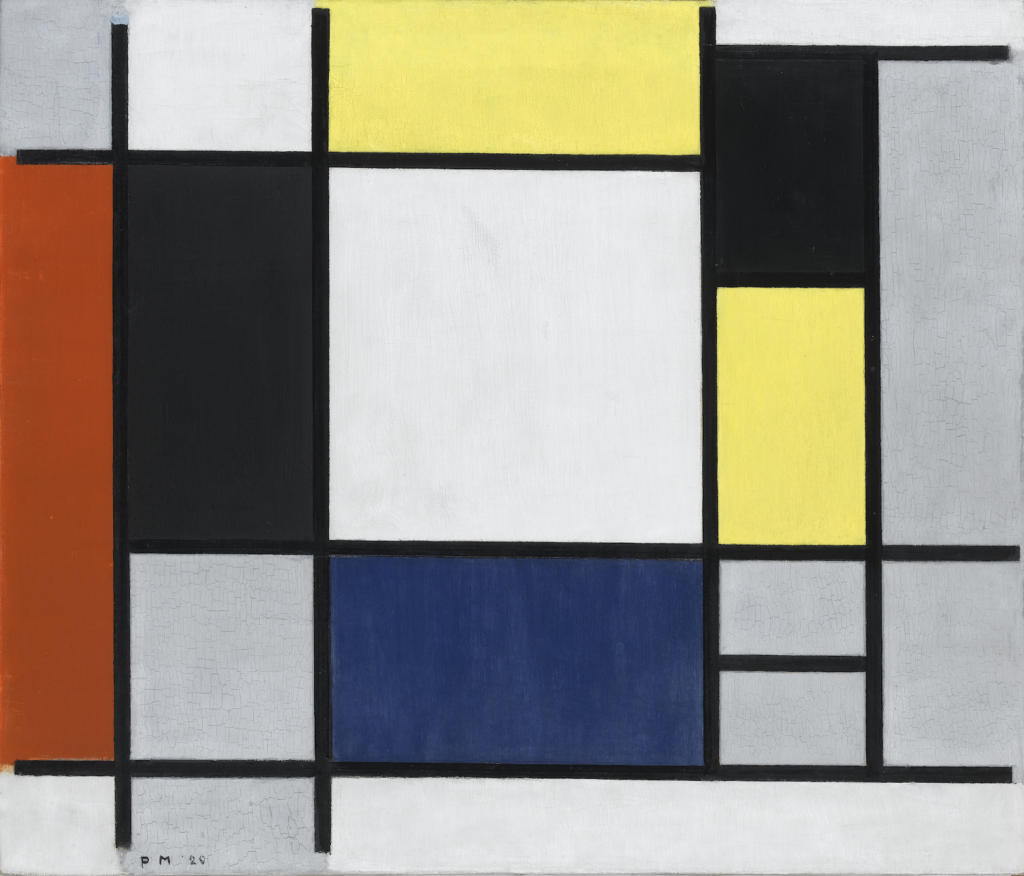Fans of Piet Mondrian May Greet a New Biography of the Pioneering Abstract Painter With a Chef’s Kiss
The Mondrian that emerges from Nicholas Fox Weber’s long, thoroughly researched, and, in the end, heroic book is an odd bird, an unstoppable temperament and, yes, a great painter.

‘Mondrian: His Life, His Art, His Quest for the Absolute’
By Nicholas Fox Weber
Alfred A. Knopf, 656 Pages
What was up with Piet Mondrian and those kisses? Among the discoveries in a new biography of the pioneering abstract painter by Nicholas Fox Weber, “Mondrian: His Life, His Art, His Quest for the Absolute,” is the length and intensity of the artist’s pucker.
That Mondrian (1872-1944) planted a kiss on the lips of socialite and collector Peggy Guggenheim has, I gather, been part of the lore surrounding the inventor of Neo-Plasticism. Mr. Weber writes that Guggenheim was taken aback by Mondrian in that the kiss “seemed completely out of character for the man because of the apparent asexuality of his art.”
Guggenheim wasn’t the only woman to experience Mondrian’s attentions. A scion of a wealthy family, Eva de Beneditty, was deeply taken with the “painter with a beard, living in an attic and eating rice out of poverty.” On one occasion, Mondrian kissed her for a continuous 30 minutes. De Beneditty marked the time by keeping an eye on a church steeple clock situated directly outside the window.
Unwanted romantic advances shouldn’t be made light of, and though de Beneditty considered each kiss “an endurance test,” she genuinely cared for Mondrian. Still, “my painter” was skittish in his communings with women — Mondrian never married and may never have had sexual relations. Was de Beneditty’s being a Jew an additional factor in his moving on?

Mondrian’s close friend, Albert Van Den Briel, worried about the artist’s “clear dislike of Jews.” Mr. Weber wonders if Mondrian’s anti-semitism may have been “tied up with dependency”: Jews were among the artist’s most important patrons and enthusiastic champions. Or was Mondrian peering over his shoulder and worrying about his lineage? Until the end of his life he fretted over his father’s “looking Jewish.”
The artist’s parents, Pieter Cornelis Mondriaan and Johanna Christina Kok, were members of the Orthodox Protestant church, a sect that adopted a strict variation of Calvinism. Mondriaan paterfamilias was ruthlessly devout. After being appointed the headmaster of the Orthodox Protestant school at Amersfoort, Mondriaan took his family to rural Winterswijk. It was in the so-called rear corner of Holland that young Piet was taught painting by his Uncle Frits.
Frits Mondriaan was a purveyor of luxury items in the Hague — wigs being a mainstay of his concern. The summers he spent at Winterswijk with his brother’s family allowed the cosmopolitan businessman to pursue painting, a metier to which Frits proved capable: His iterations of 17th-century Dutch landscapes were comfortable fodder for newly moneyed collectors. When nephew Piet showed interest in drawing and painting, Frits took the young man under his wing. They became close, with Frits providing the adolescent Piet an avenue to find his own voice.
The relationship between uncle and nephew would ultimately be rent asunder as would the good name of Mondriaan. Should you have been wondering about the back-and-forthing of the second “a” in Mondriaan, realize that it is at the behest of Frits. When Mondrian achieved notoriety by adopting modernist methodologies, his uncle placed a statement in a local newspaper demanding that Piet alter his last name. Excising an “a” was, in Frits’s estimation, the most efficient way for culture mavens to distinguish between the real artist and his “depraved nephew.”
Having grown up under his father’s stern dominion, Mondrian would adapt a not dissimilar ethos in his life and art. Although he flirted with anarchism and fell for Theosophy, Mondrian kept a tight ship — sartorially as well as in terms of aesthetics. He was also, of all things, an enthusiastic dancer. Mondrian loved jazz, particularly boogie-woogie music. The author’s descriptions of how the artist moved on the dance floor — herking-and-jerking in contrapuntal movements not unlike the rhythms generated in his signature pictures — make for lively reading.
The Mondrian that emerges from Mr. Weber’s long, thoroughly researched, and, in the end, heroic book is an odd bird, an unstoppable temperament and, yes, a great painter. Global events, not least two world wars, had Mondrian shuttling between Holland, France, England, and America. He ended his days at Manhattan under the patronage of a painter, Harry Holtzman, and became close with a journalist, artist, and mystic, Charmion von Wiegand. The fervent advocate of 90-degree angles lies in rest at Cypress Hills Cemetery.
Mr. Weber writes about Mondrian’s art — its tangencies, quirks, and quixotic ambitions — in a manner that is perceptive, clearly articulated, and not entirely uncritical. He takes into account how the artist’s attenuated pictorial vocabulary embodied and, in important ways, emboldened his vision. Listen to Mr. Weber sing the praises of the painting titled “New York City I”: It is “an unrivaled testimony to energy, to courage, to the music of life … extreme intelligence and rational preparation serve the higher goal of playfulness. Fun is the business of life. And life is, quite simply, inexpressibly wonderful.”
A bit rich, perhaps, but anyone who has communed with Mondrian’s art knows how it can shimmer and shimmy with the best of them. “Mondrian: His Life, His Art, His Quest for the Absolute” is a biography of rare nuance and keen insight — a gift, in other words, for anyone fascinated by 20th-century art and culture.

